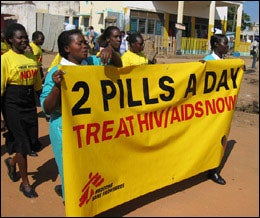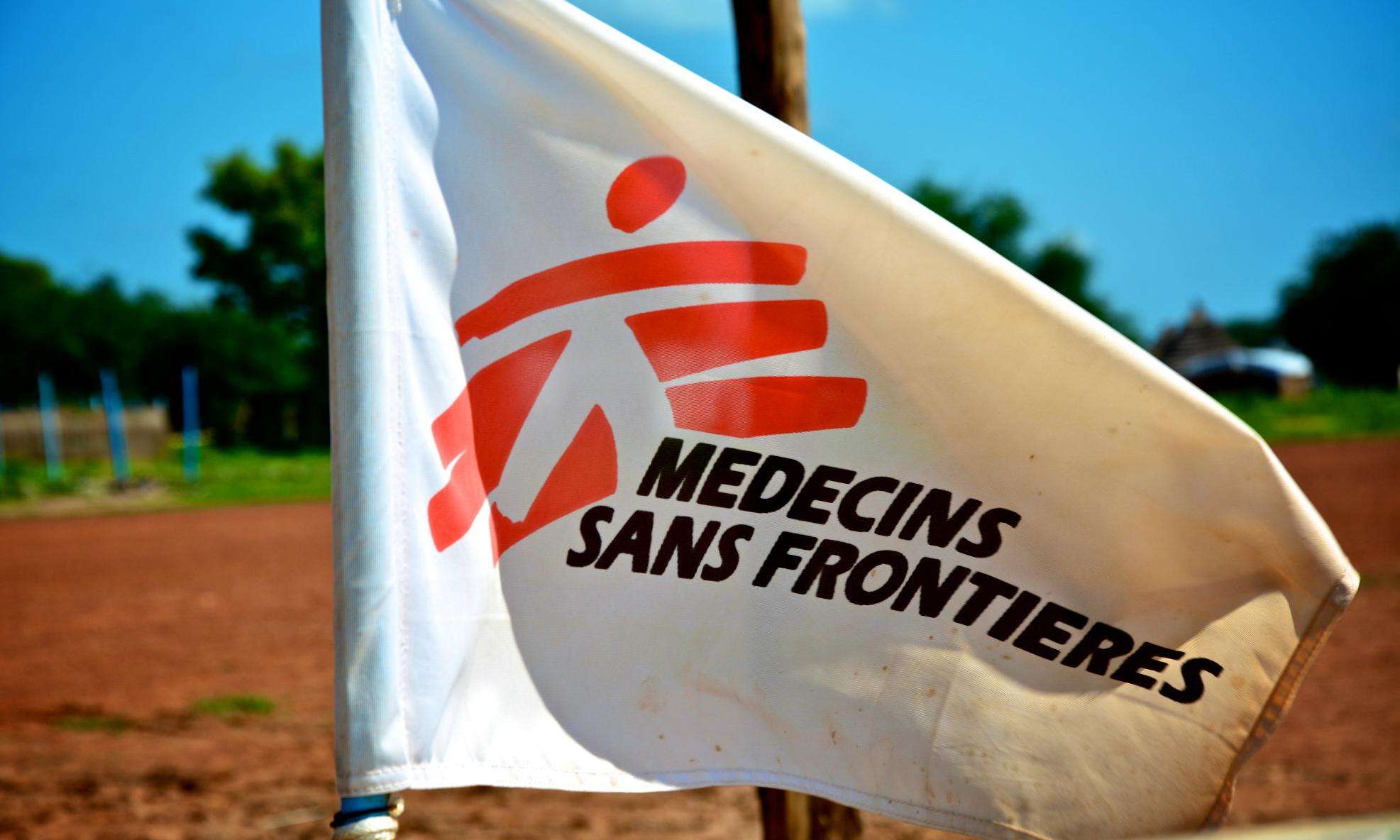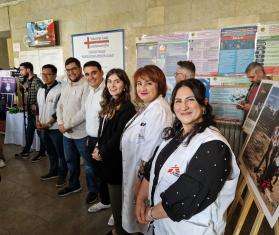The benefits of treatment are clear. Patients are doing well: their immune systems are stronger, they are gaining weight, and are able to live fuller and longer lives. Clinical results in MSF programs, which parallel those found in wealthy countries, have been published in peer-reviewed medical journals and presented at international conferences. Consolidated 2004 data from all MSF projects show a median CD4 increase of 135 cells after one year of therapy and 208 after two years of therapy and average weight gain of three to five kilograms. Probability of survival after two years on treatment was 85.3 percent (73.2 percent including both deaths and patients lost to follow-up). In addition, adherence to treatment is very good, often exceeding 90 percent.
Number of Patients on antiretroviral treatment
in MSF programs worldwide

LESSONS LEARNED SO FAR
The number of patients treated with ARVs in MSF projects has increased rapidly. Today, MSF treats 150% more patients than in December 2003 (see fig.1 above). MSF has learned from its experience treating people in resource-poor settings that increasing the number of patients on treatment requires simplification measures such as:
• Simplifying treatment regimens
Using fixed-dose combinations (FDCs – several medicines in one pill) reduces patients' pill burden and makes it easier for them to adhere to treatment. As of May 2004, 76% of new patients within MSF projects were starting treatment on a one-pill-twice-a-day regimen. The most frequently used FDC is a triple combination of lamivudine, stavudine, and nevirapine, usually sourced from generic manufacturers.

Celebrants marching in Arua, Uganda, marking 2 years of free ARV treatment. © 2004 MSF |
• Simplifying patient inclusion criteria
Rather than insisting on CD4 count and other laboratory tests, MSF programs allow patients in late stage III and stage IV to start treatment based on their clinical signs. Other measures include disbanding selection committees and holding counselling sessions for groups rather than for individuals.
• Free treatment and adherence
MSF believes that it is essential to ensure that even the poorest people have access to life-saving treatment. The main cause of treatment interruption in countries where patients are charged for their treatment is the cost. To minimize non-adherence due to inability to pay, nearly all MSF programs provide ARVs free of charge.
• Decentralizing care
Offering care closer to communities in need, e.g. at local health clinics, allows patients to start treatment without needing to attend a district or national hospital that might be several hours' away. Devolving responsibility to nurses and clinical officers and training non-medical people as counsellors helps deal with staff shortages and heavy workloads and therefore enables programs to reach more people.
|
• Seeking out least expensive quality ARV
By stimulating competition between producers and overcoming patent barriers when necessary, MSF and some governments have brought down costs to below $300 per patient per year. MSF considers three main sources of quality assurance in deciding which drugs to use in its projects: the National Drug Regulatory Authorities, the World Health Organization (WHO) pre-qualification project and MSF's internal qualification system that follows standard procedures for pharmaceutical procurement.
• Community participation
Many MSF programs work closely with associations of people living with HIV/AIDS and other community activists to strengthen prevention, bolster voluntary testing and counselling, enhance treatment education, and promote adherence to treatment.
BEATING THE PANDEMIC
Research priorities
Much of today's research into HIV/AIDS diagnostic and treatment tools is still targeted at developed country patients attending fully equipped, modern clinics. Yet the vast majority of patients living with HIV/AIDS live in developing countries. If we are to really extend the numbers of people accessing ARVs, priority must be given to research that focuses on the needs of patients in developing countries, and their specific conditions.
• Simple rapid diagnostic tests and monitoring tools
Current research focuses on developing new high-tech methods to measure patients' virological outcomes (resistance genotyping, etc.). Many of these tools are inappropriate for use in developing countries. Operational research is needed to come up with means of improving clinical diagnosis (when to start treatment, when to switch treatment) for use in resource-poor settings. In the longer term, simple and inexpensive rapid test are needed that would, for example, clearly indicate from a drop of blood whether a patient has a CD4 below 200 or would show that a viral load is above 5000 copies. In addition, research on how to most benefit from monitoring tools is essential.
|
• Specific pediatric formulations
The lack of pediatric formulations makes determining and administering pediatric doses complex and burdensome and often leads to over- or under-dosing. Treating a child also costs five or six times more than treating an adult. Industry must begin producing pediatric formulations of ARVs, in particular pediatric fixed-dose combinations (several medicines in one tablet), and at lower prices. New diagnostic and monitoring devices and clearer treatment guidelines are also needed to assist clinicians in the task of starting children on ARV treatment.
• TB and HIV
In some countries, up to 70% of people who have tuberculosis (TB) also have HIV/AIDS. Yet diagnosing TB in patients with HIV/AIDS is difficult: sputum smear microscopy only shows up positive results in about a third of patients, and clinical diagnosis is complicated by the many symptom similarities between AIDS and TB. Treatment is also problematic: nevirapine, a component of the most commonly used, WHO-recommended ARV treatment regimen, cannot be used at the same time as a key TB medicine, rifampicin. Switching to other compatible drugs means a much higher pill count for co-infected patients. There is a clear and urgent need for new diagnostic tools to detect all forms of TB in all patients – including people living with HIV/AIDS, children, and people with extrapulmonary TB – and for fixed-dose combinations of ARVs that can be taken at the same time as key TB drugs.
|
• Affordable second-line drugs adapted to resource-poor settings
We need access to low-cost, effective and easy-to-use second-line drugs, so that when patients fail their first-line treatment, they have another set of medicines to fall back on. Current second-line drugs are very expensive: annual treatment costs jump from $250 a year to $700-3000 because there is no generic competition. They are also difficult to take: daily pill count increases from two for first-line to up to 16 for second-line. Drug companies, both originator and generic, must reduce their prices for second-line ARVs and develop new formulations adapted to resource-poor settings.
MSF has serious concerns about supplies of affordable quality medicines in the future. On January 1, 2005, all members of the World Trade Organization (WTO) are required to be fully compliant with the WTO TRIPS (Trade-Related Aspects of Intellectual Property Rights) agreement and start granting 20 year patents for pharmaceutical products. Only the least developed countries can postpone this until 2016. This means that affordable sources of new medicines will gradually dry up as patents will be granted on all new medicines and some existing medicines produced by generic manufacturers in countries like India. It is unlikely that affordable generic sources of second-line ARVs will be available any time soon. In general, lack of competition between manufacturers will result in higher drug prices.
|
Infrastructure and human resources
• Staffing
National scale-up efforts have only started in a handful of countries, such as Brazil, Thailand, South Africa, Zambia, and Malawi. In other countries, efforts to expand treatment are moving very slowly. The health infrastructure of many developing countries is weak, and there is often a critical shortage of medical professionals and lack of specialist knowledge to run national treatment programs. For example, there is often little capacity to procure safe and effective antiretroviral drugs at the lowest affordable price.
• Training
Training staff is an essential part of making ARV treatment programs successful. Governments, international organisations and NGOs should put more effort into training new nurses, clinicians, and other medical and non-medical professionals. Technical assistance should also be extended for matters such as procurement.




